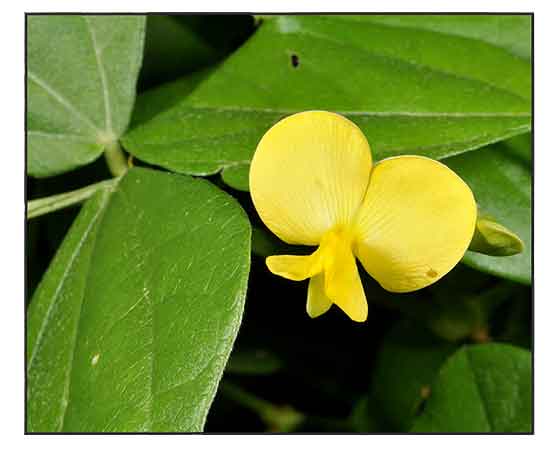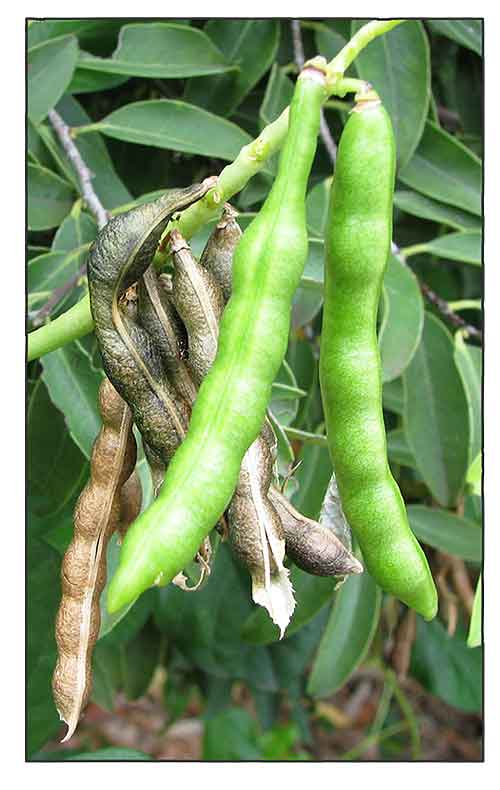 Gen info Gen info
- Vigna is a genus of plants in the legume family, Fabaceae, with a pantropical distribution. Some are former members of the genus Phaseolus. According to Hortus Third, Vigna differs from Phaseolus in biochemistry and pollen structure, and in details of style and stipules. Vigna is commonly confused with the genus Dolichos, but differ in stigma structure. Vigna are herbs or occasionally subshrubs, with pinnate, trifoliate leaves. (8)
-
Vigna marina is a prostate, creeping vine and perennial plant, a species of legume in the family Fabaceae. (2)
- Etymology: The genus name Vigna honors Dr. Dominico Vigna, an Italian doctor and horticulturist, a professor of botany at the University of Pisa. The species epithet marina derives from Latin meaning "sea", refers to the species' coastal habitat and tolerance to salt.
 Botany Botany
• A short-lived, perennial, non-woody prostrate, creeping vine and perennial plant. Stems grow up to 3-4 meters long, and often have purplish stripes. Leaves are trifoliate and are light green in color. They grow from the stems, each on a stalk of about 2 to 5 cm long, and are arranged alternately. Small, triangular leaf-like stipules are located at the junction where the leaf stalk meets the stem. Three triple-nerved leaflets comprise each leaf, smooth-edged, and broadly oval to oblong in shape, with a pointed tip, 4 to 10 cm in length, and 2 to 5 cm in width. Flowers are yellow in color, and are pea-type in shape, growing from stalks which have a maximum length of approximately 10 cm. Flowers are between 15 and 18 mm long, and grow in clusters around the tip of the stalk. Flowers are non-fragrant, occurring year round, but mostly in the autumn and early winter. Pears are circular to oblong in shape, and have a grayish-brown color, growing within rounded pods in groups of 4 to 9. Pods are up to 8 cm in length and 6 mm wide. Ripened peas are released when the pod opens and then twists. (2)
 Distribution Distribution
- Native to the Philippines.
- Also native to Aldabra, Andaman Is., Bangladesh, Bismarck Archipelago, Borneo, Cameroon, Caroline Is., Central African Republic, Chagos Archipelago, China Southeast, Cocos (Keeling) Is., Congo, Cook Is., Equatorial Guinea, Fiji, Gabon, Ghana, Gilbert Is., Gulf of Guinea Is., Hainan, Hawaii, India, Ivory Coast, Japan, Jawa, Kazan-retto, KwaZulu-Natal, Laccadive Is., Lesser Sunda Is., Liberia, Madagascar, Malaya, Maldives, Maluku, Marianas, Marshall Is., Mauritius, Mozambique, Myanmar, Nansei-shoto, Nauru, New Guinea, New South Wales, Nicobar Is., Nigeria, Niue, Norfolk Is., Northern Territory, Ogasawara-shoto, Queensland, Réunion, Samoa, Seychelles, Society Is., Solomon Is., South China Sea, Sri Lanka, Sulawesi, Sumatera, Taiwan, Tanzania, Thailand, Tokelau-Manihiki, Tonga, Tuamotu, Tubuai Is., Tuvalu, Vanuatu, Vietnam, Wallis-Futuna Is. (1)
Constituents
- No phytoconstituent studies found.
Properties
- Considered anthelmintic, diuretic, spasmolytic.
Parts used
Leaves, roots, stems, stalks.
Uses
Edibility
- All parts of the plant are edible. Seeds may be cooked or dried. Cooked leaves eaten as vegetable. In Australia, thick roots eaten after roastinG. Raw immature peas taste like common garden pea (Pisum sativum), with a more bitter aftertaste. (3)
Folkloric
- No reported folkloric medicinal use in the Philippines.
- In Papua New Guine, juice from crushed leaves in lime an water
drunk for treatment of stomach aches. Leaf juice given to children for treatment of asthma. Heated leaves used as poultice on sores. In Hawaii, leaves, stalk, midribs, and stems are pounded until soft, then applied to wounds and hehe (boils, running sores, ulcers). (3)
- In Samoa, leaves with fisoa (soap bush, Colubrina asiatica), taken internally for fulamaua (umete). Leaves used externally for ma'i tafafao (acute mental symptoms, sleeplessness). Leaves taken internally with togo (Centella asiatica / Asiatic pennywort) for pua'i toto (vomiting or coughing up of blood). Leaves taken internally and externally for tulita fasia (urinary tract infection). Roots, wtih lapa lapa (blunt end of coconut frond), taken internally for sila'ilagi se (perianal carbuncle). (4)
- In Bangladesh, considered anthelmintic, diuretic, spasmolytic. Used for treatment of asthma, boils, fever, and stomachache. (7)
Others
- Agroforestry: The plant can fix nitrogen fro the air around its roots, via the microorganisms on the nodules of the roots. Used as sand or dune stabilizer. It can also prevent coastal erosion. (•) Plant is also a promising cover crop in saline soils.
- Forage: Livestock feed when cut as green forage.
- Landscaping: A suitable species for landscaping uses in tropical coastal areas. (3) Used as accent plant, ground cover, trellis or fence climber.
Studies
• Salt tolerance: Sea water intrusion into soils by global climate change and tsunami disasters is a significant factor contributing to soil salinization in coastal vegetation areas, which poses critical threat to agriculture and food security. Study evaluated the seawater tolerance of V. marina, a wild Vigna species. Unlike seeds of V. radiata (mung bean) and V. angularis (adzuki bean), V. marina seeds exhibited buoyancy in seawater, remaining afloat for at least 30 days, retaining a 100% germination rate, while Vr and Va failed to germinate under the same conditions. (5)
• Potential as Salt Tolerate Legume: Study evaluated the potential use of V. marina as salt tolerant legume in salty land. Total dry biomass, chlorophyll and antioxidant (vitamin C, anthocyanin, and alkaloid) contents were determined. The dry biomass of marine bean was not significantly different among different treatments. The contents of chlorophyll a and b and antioxidant were significantly higher at salinity concentration of NaCl 400mM, indicating higher salt concentration induced higher chlorophyll and antioxidant contents as mechanisms of growth in salty land. Results suggest the legume is salt tolerant and has potential as productive legume at coastal salty land. (6)
Availability
Wild-crafted. |

![]()



 Gen info
Gen info
 Distribution
Distribution